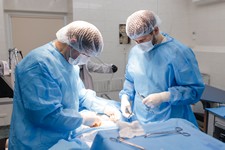

















Laparoscopic Salpingectomy
What is a salpingectomy (removal of the fallopian tube)?
Salpingectomy or tubectomy is a surgical procedure in which a surgeon removes one or both fallopian tubes. The fallopian tubes are ducts between the ovaries and the uterus. The fallopian tubes play a crucial role in a woman's reproductive function by ensuring the transport of sperm, the fertilization process, and transporting the fertilized egg back to the uterus.
What are the types of salpingectomy (tubectomy)?
- Unilateral salpingectomy: One fallopian tube or part of only one fallopian tube is removed. This means you can still get pregnant, as you still have one fallopian tube. This type is typical for conditions such as ectopic pregnancy or blockage of only one fallopian tube.
- Bilateral salpingectomy: This is when both fallopian tubes are completely removed. You will not be able to conceive naturally after this operation. This type is common in cases such as fallopian tube cancer or when you want to prevent pregnancy permanently.
What are the indications for salpingectomy?
- Tubal pregnancy
- Uterine cancer, certain types of cervical cancer, ovarian or fallopian tube cancer
- Infection in the fallopian tubes
- Endometriosis in the fallopian tubes
- Blocked or damaged fallopian tubes (e.g., hydrosalpinx)
- For contraception (sterilization)
If you have a higher risk of developing ovarian or breast cancer, you may consider this operation to reduce the risk.
How can removing the fallopian tubes prevent cancer?
Removing the fallopian tubes is a way to protect against certain types of cancer, especially if you have a BRCA gene mutation. If you have this gene mutation, the risk of developing breast and ovarian cancer is significantly higher. Salpingectomy is one of the risk-reduction strategies we can recommend. This is because some forms of ovarian cancer often begin in the fallopian tubes.
How effective is salpingectomy in preventing ovarian cancer?
Many studies have been conducted to determine how successful salpingectomy is in preventing cancer. The general conclusion is that this procedure is very effective in preventing ovarian cancer, with an overall risk reduction of about 80%.
What happens during salpingectomy?
There are two surgical methods for salpingectomy:
- Laparoscopic salpingectomy: During this surgery, a laparoscope, which is a thin instrument with a light and camera at the end, is used. The laparoscope is inserted into the abdomen through a small incision. Then your abdomen is inflated with gas to allow the surgeon to see your uterus and fallopian tubes in detail. Specialized surgical instruments are inserted through other small incisions in the abdominal cavity to remove the fallopian tubes. After the fallopian tubes are removed, they are placed in a special container and evacuated from the body through the central trocar near the navel. The skin is closed with dissolvable stitches.
- Open abdominal salpingectomy: The surgeon makes a large incision in the abdomen (called a laparotomy) to access the fallopian tubes. The surgical technique is similar to the laparoscopic one, but the disadvantage is that the patient is left with a large scar and a longer recovery period.
I prefer laparoscopic surgery because it is less invasive, has a shorter recovery time, and a lower risk of complications.
How long does salpingectomy take?
It depends on the access used by the surgeon. Laparoscopic surgery takes about 15 to 30 minutes. Open abdominal salpingectomy may take several hours.
What is the postoperative period like?
- You can get out of bed 3-4 hours after the surgery.
- You can eat light food and drink a few hours after surgery.
- Dressings are applied daily while in the hospital.
- After discharge, no further dressings are needed at home.
- You can take a shower the day after surgery; bathing is allowed after 3-4 weeks.
- Limit physical activity (sports, swimming, running) for up to 2 weeks, but otherwise, you can live your normal life.
- Limit sexual activity for 1-2 weeks.
- Special gel is prescribed to prevent scars.
- The results of histological examination come in 10-14 days, and we will meet to discuss them.
- A follow-up examination and ultrasound, if there are no complaints, are usually recommended after 1-2 months.
What is normal after laparoscopic tubal surgery?
- Moderate discomfort in the lower abdomen, at the sites of postoperative wounds
- A slight increase in body temperature up to 37.5°C, sometimes even higher, if the temperature only rises in the evening and is managed by taking paracetamol 500-1000 mg
- Slight bloating, constipation, or diarrhea in the first few days after surgery
- Mild weakness, drowsiness
- Vaginal spotting for several days to 2-3 weeks after surgery
- Menstrual cycle disruption (menstruation may come earlier or later than expected)
- Chest pain, especially on the right side and near the right collarbone (a consequence of pneumoperitoneum—pressure from the carbon dioxide used during laparoscopy). This is harmless and usually resolves within 2-3 days at most.
We will discuss all questions regarding the surgery and the postoperative period during our meeting at the clinic.
You can view these and other surgeries on my YouTube channel.





